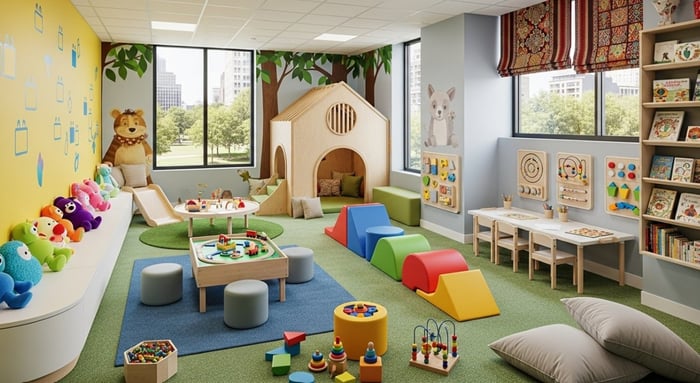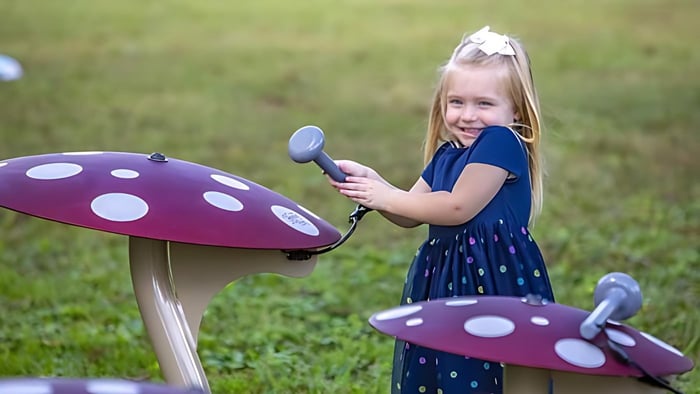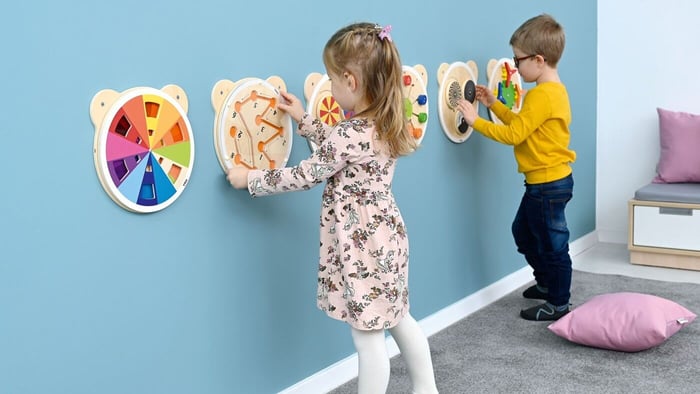
How Sensory Wall Panels Enhance Learning for Children
Table of Contents
Sensory experiences play a vital role in a child's development. As children grow, their brains develop at a rapid rate, absorbing new information, making connections, and exploring the world around them. Sensory experiences—engaging sight, sound, touch, taste, and smell—are crucial for early learning. One of the most innovative ways to support sensory development is through sensory wall panels. These engaging and interactive panels are designed to stimulate various senses while encouraging learning through hands-on activities. This article explores the importance of sensory wall panels in children's learning and how Little People’s Cove can help create a sensory-rich environment for children.
Airplane 6-Activity Sensory Wall Panel
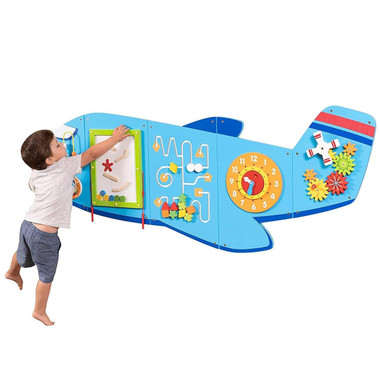
$229.00
Airplane 6-Activity Sensory Wall Panel - Large Sensory Wall Toy for Toddlers & Early Learners Take interactive learning to new heights with the Airplane 6-Activity...… read more
What are Sensory Wall Panels?
Sensory wall panels are interactive, tactile surfaces that stimulate a child’s senses. Typically made from durable materials, these panels incorporate various textures, colors, shapes, and interactive elements to engage children in learning activities. Designed to be mounted on walls, sensory panels create a space-efficient way to promote sensory play without taking up valuable floor space. They are especially useful in environments like classrooms, daycare centers, therapy rooms, and even home play areas.
Sensory wall panels can offer a variety of sensory experiences, including:
- Tactile stimulation: Surfaces with different textures, such as rough, smooth, bumpy, or squishy, provide a rich tactile experience. This helps children develop their sense of touch, motor skills, and hand-eye coordination.
- Visual stimulation: Bright colors, patterns, and visually engaging elements like mirrors and lights encourage visual exploration. This supports visual tracking, attention, and color recognition.
- Auditory stimulation: Panels with sound-producing elements, such as bells, chimes, or music, enhance auditory processing and listening skills.
- Cognitive stimulation: Many sensory wall panels include activities that promote problem-solving, spatial awareness, and cognitive skills, such as puzzles, mazes, and sequencing tasks.
How Sensory Wall Toys Help Children Learn
1. Boosting Cognitive Development
Sensory wall panels support cognitive development by offering opportunities for problem-solving and creative thinking. Many panels include interactive elements like puzzles, gears, or buttons that children must manipulate to create a desired outcome. This type of hands-on interaction strengthens cognitive abilities by encouraging children to think critically, make decisions, and understand cause and effect. For instance, a panel with gears that move when turned promotes an understanding of mechanical concepts and spatial reasoning.
In addition to problem-solving, sensory wall panels help children build early math skills. Panels with counting activities, shapes, and patterns introduce children to basic mathematical concepts like quantity, sequence, and spatial relationships. As children engage with these elements, they develop a foundation for future learning in subjects like math and science.
2. Enhancing Fine Motor Skills
The tactile nature of sensory wall panel toys helps develop fine motor skills, which are critical for tasks such as writing, drawing, and self-care. When children interact with panels that require them to press buttons, move levers, or manipulate small objects, they strengthen the muscles in their hands and fingers, improving dexterity and hand-eye coordination. Activities like threading beads, tracing shapes, or turning knobs promote the development of hand strength, grip, and precision.
These fine motor skills are essential for academic success and everyday tasks. Sensory wall panels offer a fun and engaging way to practice these skills in an environment that fosters both learning and play.
3. Supporting Sensory Integration
Sensory integration refers to the brain’s ability to process and respond to information received through the senses. Sensory wall panels provide a rich, multi-sensory environment where children can experience a variety of sensory inputs simultaneously. For children with sensory processing disorders or those on the autism spectrum, sensory wall panels can be especially beneficial. These panels allow children to explore sensory stimuli in a controlled and safe setting, helping them regulate their responses and develop coping strategies.
Sensory activities can help children become more aware of their sensory preferences, whether they are seeking out tactile input, visual stimulation, or auditory experiences. By offering a range of sensory options, sensory wall panels support children in developing sensory regulation skills, which are essential for emotional and social development.
4. Encouraging Language Development
Many sensory wall panels include elements that encourage verbal communication, either by prompting children to name objects, describe actions, or work collaboratively with others. For instance, panels with pictures or objects that can be labeled help children develop their vocabulary. Additionally, some sensory wall panels incorporate sound effects or music that can prompt children to repeat words, sing, or engage in conversations.
By offering opportunities for children to practice speaking, listening, and responding to stimuli, sensory wall toys play a vital role in fostering language development. These panels can help children expand their language skills in a fun and interactive way.
5. Fostering Emotional Regulation
Sensory wall panels also play a role in emotional development. By offering children a calming space where they can focus on sensory activities, these panels help children regulate their emotions and cope with stress. Sensory inputs like soothing colors, soft textures, or gentle sounds can have a calming effect, providing children with a safe place to self-soothe when they feel overwhelmed.
For children who experience anxiety, overstimulation, or frustration, sensory wall panels offer a structured, soothing environment that can help them regain focus and calm down. These activities promote emotional awareness, self-regulation, and a sense of accomplishment, which are important skills for lifelong emotional well-being.
Meadow with Ladybug Sensory Wall Panel
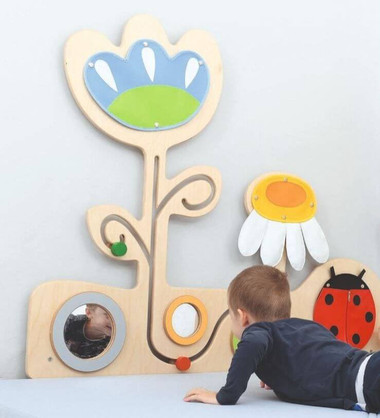
$763.35
Meadow with Ladybug Sensory Wall Panel - A Garden of Tactile Surprises Bring playful exploration to life with the Meadow with Ladybug Sensory Wall Panel....… read more
How Little People’s Cove Can Help Create a Sensory Environment
At Little People’s Cove, we are dedicated to providing innovative and effective solutions to support sensory development in children. We specialize in creating customized sensory environments that cater to the unique needs of each child. Whether you're outfitting a classroom, therapy room, or home play area, our sensory wall activities offer an excellent way to enhance a child’s learning experience.
Here’s how Little People’s Cove can help you create the perfect sensory environment:
1. Customized Sensory Solutions
Every child’s sensory needs are different, and we understand that creating a personalized sensory environment is key to fostering a positive learning experience. Our team at Little People’s Cove works with you to design sensory wall activities tailored to your space, budget, and specific learning objectives. Whether you need panels for sensory integration, fine motor skill development, or cognitive learning, we offer a variety of designs and features to meet your needs.
2. Durable and Safe Materials
We prioritize safety and durability in all our products. Our sensory wall toys are made from high-quality materials that are both safe for children and built to withstand frequent use. We ensure that our panels meet industry safety standards, so you can rest assured that children will be interacting with secure, reliable products.
3. Educational and Engaging Designs
Our sensory wall panels are not only functional but also engaging and educational. We incorporate a wide range of interactive elements designed to stimulate curiosity and learning. From textured surfaces and moving parts to sound effects and visual displays, our panels encourage children to explore and discover in a way that’s both fun and educational.
4. Support for Diverse Learning Needs
Whether you’re creating a sensory-rich environment for children with autism, ADHD, or general developmental needs, our sensory wall toys can be adapted to support a wide range of learning requirements. We provide options that promote sensory regulation, cognitive growth, fine motor development, and more.
Rainbow Activity Wall Panel Toy
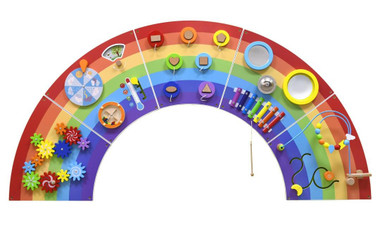
$249.99
Rainbow Activity Wall Panel Toy - Multi-Panel Sensory Wall System for Toddlers Fill early learning spaces with color, motion, and discovery using the Rainbow Activity...… read more
Conclusion
Sensory wall panels are a fantastic way to support children’s development by providing interactive, hands-on experiences that engage multiple senses. From cognitive growth and fine motor development to sensory integration and emotional regulation, these panels offer a wide range of benefits for young learners. Little People’s Cove is here to help you create a customized, sensory-rich environment that nurtures growth, learning, and fun for children of all ages. Whether you're looking to enhance a classroom, therapy room, or home play area, our sensory wall panels are a perfect solution for promoting learning through sensory exploration.
FAQs
How do sensory wall panels support learning in children?
Sensory wall panels engage multiple senses—sight, touch, and sometimes sound—helping children process information more effectively. By offering hands-on interaction, they strengthen fine motor skills, problem-solving, and concentration. For children with autism or sensory processing challenges, panels provide structured sensory input that supports emotional regulation and readiness to learn.
Are sensory wall panels good for classrooms and therapy centers?
Yes—sensory wall panels are ideal for schools, therapy centers, libraries, and waiting rooms. They promote independent exploration, reduce anxiety during transitions, and provide a quiet, engaging alternative for children who may struggle in overstimulating environments. Teachers often use them as a calming tool or as part of a learning center to reinforce early concepts like shapes, colors, and sequencing.
What developmental skills do sensory panels help build?
Sensory wall panels help children develop:
- Fine motor control (turning gears, sliding pieces, pressing buttons)
- Hand-eye coordination and spatial awareness
- Cognitive skills like cause-and-effect reasoning and pattern recognition
- Social skills when children explore panels together, practicing turn-taking and cooperative play
These skills directly support academic readiness in areas like writing, math, and problem-solving.

